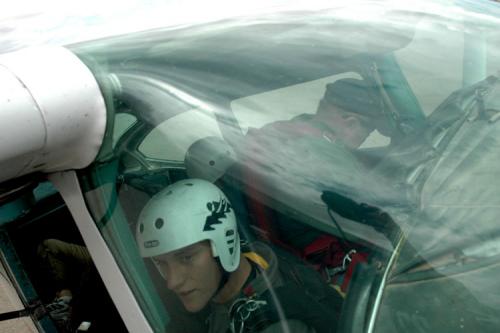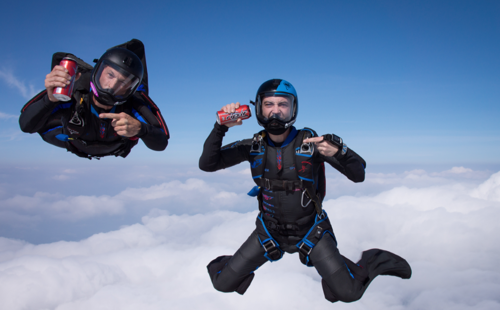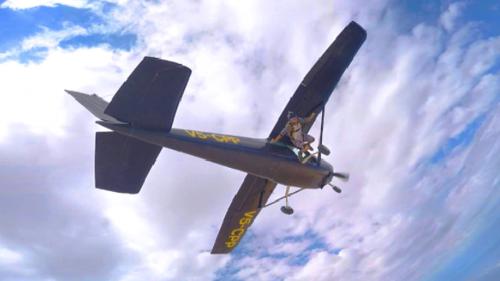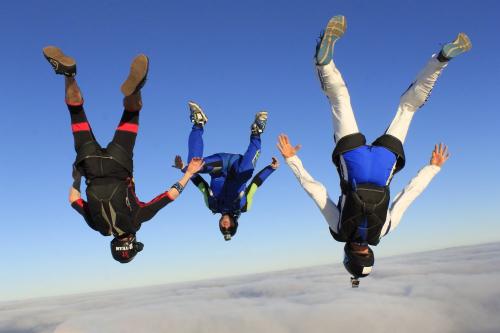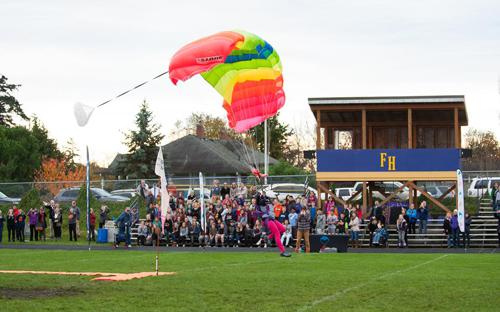How To Be A Good Passenger in a Jump Plane
How to be a Good Passenger in a Jump Plane
Note: Original text from an article written for April 1992 Parachutist. Since 1992 our fleet of jump airplanes has changed signifigantly. There are few planes like DC3's in use now which often have "loaders", and many pilots are now spotting airplanes with the help of the navigation equipment that is now more advanced. Please make adjustments for the changing technology. G.P. 2003
This article is written in two parts covering some of the most typical jump plane situations you will experience. The first part will be of interest to new jumpers who are learning to spot and to jumpmaster themselves and who are jumping from small airplanes. The second part is for intermediate jumpers from a small drop zone who may soon consider visiting another drop zone or going to a skydiving event that has larger airplanes. It will also be good review for experienced jumpers who do not jump large airplanes very often and forget how to be a good passenger.
Small Airplanes:
Loading-
Loading a small airplane will become different as you gain more experience in skydiving. You will be doing different exits than you did as a student and will need to be arranged differently in the airplane. First of all, take the advice of more experienced jumpers as to the most efficient place to be for your skydive. If you are in an airplane with students, follow the seating arrangement that the instructor specifies. Be careful as you get near the airplane if the engine is still running. The door of small airplanes is always near the prop and the airplane owner will not appreciate you bending the prop by backing into it. :) The least noisy time during your flight is during loading and is the best time to tell the pilot how high you are going and in what direction you want the jump run. The pilot needs to tell Air Traffic Control how high the plane is going and hopes you won't change your mind too many times on the way up. Tell the pilot if you will being doing Canopy Relative Work or will be opening high for some reason. Pilots don't want to do surprise CRW with canopies they don't know are up that high. The position of the seat belts in the airplane will usually dictate exactly where you will be sitting. If this position is uncomfortable just remember that the Federal Aviation Regulations state only that you must wear them only while the aircraft is in motion on the ground and during takeoff and landing. Make sure that everyone doesn't sit too far to the rear and make the plane out of balance. The pilot would not have much fun flying it in this condition. Ask the pilot for advice on loading if you do not know.
Jump Run-
When you know it is almost time to jump you will usually be getting to your knees and making final adjustments to your gear. In getting up, try not to pull yourself up by the pilot's rig or pull any important items off the plane in doing so. Check for any part of your gear that may have been moved while getting up in a crowded airplane, especially your hand deploy pilot chute. There should be no need to say very much to a pilot at this point if they were sufficiently briefed on the ground, but be alert and understanding about anything the pilot may say to you. Your jump may be delayed while waiting for another jump plane or from instructions from Air Traffic Control, and those instructions will be hard to hear if you are yelling about why you aren't on jump run yet.
Spotting-
You will always need to wait for a signal from the pilot before opening the door. If the airspeed is too high the door will receive excessive stress and might even come off. The airplane's owner would be very unhappy with you as well as the home owner whose roof the door lands on. Giving corrections to the pilot on direction of flight can be verbal by saying "5 RIGHT" or "5 LEFT", or by simply pointing in the direction to turn. Most pilots will correct about 5 degrees in the direction you indicate and then level out and wait for further corrections. If you point, make sure your hand is up where the pilot can see it. Try to keep the corrections to a minimum because the pilot probably lined you up on jump run pretty close anyway. If you correct back and forth too many times even the pilot will get lost. :) Most pilots will cut back on the power when you get out, but it is a good idea to call for a "CUT" anyway before exiting.
Exiting-
Try to exit the airplane and get into your position as quickly as possible so the pilot doesn't have to struggle to keep the airplane right side up. However, be careful not to bump things on the way out like your pilot chute. It is also not wise to lean on the pilot too much just to get that perfect exit position. If you push too hard on the pilot or lean on the yoke of the airplane you will have a very interesting sideways exit.
Large Airplanes:
Loading-
Loading a large plane at a new drop zone or at a large skydiving event will likely be an exciting event for you. There may be several large groups on the plane and you may get the feeling of being herded into the airplane. This is just a sense of urgency on the part of the crew, after all, these larger airplanes are more expensive to operate and must be kept busy in order to make money. Try to do your share by paying attention and helping move things along.
Although the props on larger planes are further from the door than on smaller planes there may be more of them and they may be on the sides on the plane where you are not used to avoiding them, so be careful. Many of the largest airplanes will have a crewmember called a "Loader" that is in charge of loading the airplane and determining the exit order of all the groups getting into the plane. The loader is a buffer between the jumpers and the pilot and has to keep the jumpers in line so the pilot can concentrate on more important things like flying. Pay attention to the loader because they will be able to load you as quickly and efficiently as possible. When seating yourself in the airplane you can note how the people ahead of you are seated and follow suit. Seating is usually very cozy in these airplanes even though it looks roomy when you first get in, so sit close. Somes planes have loading lines painted or taped across a rearward section of the airplane and all of the jumpers must be forward of this line. If you see that not everyone is going to fit in this area, you might as well scoot back and tighten it up before you get too comfortable because the loader is going to be mean and make you crowd together anyway. Seat belts will be available and you might have to look carefully to determine which one you should be using.
After everyone is seated and you are taxiing out to the runway, take a look around the airplane. There may be a sign somewhere describing the plane's emergency procedures in case of engine failure. You will want to be familiar with these procedures and really follow them if the real thing happens rather than just getting up and running around all excited. Some planes might also have posted a diagram of the drop zone and the jump run for the day. This is important information for the person spotting and helpful to anyone jumping at an unfamiliar airport.
Jump Run-
When it is time to jump you will be getting up to make final adjustments to your gear. Check for any part of your gear that may have been moved while getting up in a crowded airplane. There may be room in a large airplane to have someone give you a pin check. Even if it is possible to completely stand up in the airplane, don't feel like you must do this until time for your group to line up and exit. This will help reduce crowding in the plane. All adjustments to your gear can be made while kneeling anyway. Try to continue to keep forward of the loading line by not spreading out too much. The airplane may climb better like this and you might just get some extra altitude. Try keeping the noise to a minimum in case you get instructions from the loader or spotter.
Spotting-
On the larger planes the loader may also do the spotting for the whole load. This is another reason you should pay attention to and be nice to the loader, so you will make it back to the airport. Another possibility is that the pilot may be spotting from up front by using instruments and giving the exit command directly or by relaying the command to the loader. If the load is being spotted by looking out the door, the corrections must be relayed to the pilot who possibly cannot see the spotter. Some airplanes have pushbutton switches on a panel that turn on lights that the pilot can see, or the loader may have a headset to talk to the pilot. If you are spotting you will need to learn how these work ahead of time. If the plane does not use one of these methods, the corrections must be relayed to the pilot by someone sitting near the pilot that can see the spotter. For this to work there must be a clear line of sight up to the cockpit. Do your part by keeping the isle clear.
Exiting-
Wait until the loader or spotter indicates that it is time for your group to line up and then do it quickly. If you are not in the first group, continue to stay forward until it is time for you to line up. Give the group ahead of you 5 to 10 seconds before your group exits, depending on the winds aloft, but don't be slower than that. The group behind you is using the same spot as you and larger airplanes are flying faster on jump run than smaller ones. You will know when you are taking too long to exit because the group behind you will begin objecting to your excessive delay. Everyone wants to make it back to the airport.
Summary:
This article has outlined the most common procedures that you will be following when jumping out of most airplanes. Hopefully it has given you some basics on how to be a good passenger on any aircraft whether it be an airplane, a helicopter, or a hot air balloon. If you ever have any questions about the procedures for a particular aircraft, just ask the pilot. They will be glad to help.

